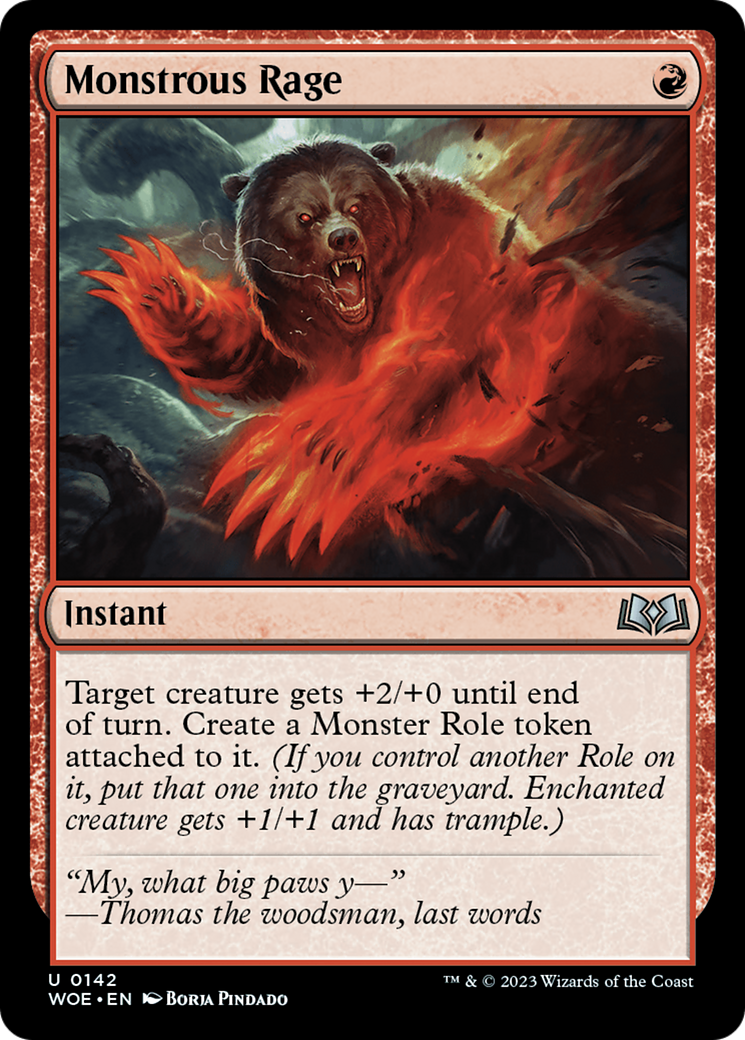Format Analysis
Should Monsterous Rage be banned?
Examining a powerful Standard card
Introduction
The recent dominance of Red aggro strategies featuring the combat trick Monsterous Rage has led some players to call for a ban. While the card has certainly made an impact on the Standard metagame, banning it would be premature and unnecessary. This article examines why Monsterous Rage represents a healthy challenge to the format rather than a problematic element that needs removal.
Understanding Monsterous Rage's Power
Monsterous Rage is undeniably efficient - a one-mana instant that provides a significant power boost and trample. Its popularity stems from several factors:
- Low mana investment with high damage potential
- Instant speed allowing for combat tricks and unexpected lethal damage
- Trample ensuring damage connects even through blockers
- Synergy with creature-heavy aggro strategies
However, power alone doesn't justify a ban - every format needs efficient cards that define archetypes.
Balanced Within the Current Metagame
The current Standard environment contains numerous answers to Monsterous Rage strategies:
- Efficient removal: Cards like Cut Down, Destroy Evil, and Temporary Lockdown can answer threat creatures before Rage becomes relevant
- Counterspells: Make Disappear and Negate cleanly answer the spell for equal or slightly more mana
- Board wipes: Several sweepers reset the board against creature-heavy strategies
- Lifegain strategies: Cards like Mythic Bloodletting and Raffine's Guidance provide stabilization against aggro decks
Statistical Context
Red aggro decks using Monsterous Rage currently represent about 22% of the competitive metagame. While strong, this is far from the 35-40% threshold that typically triggers ban considerations. Multiple archetypes maintain positive win rates against these strategies.
The Real Culprit: Manifold Mouse
It's worth noting that Monsterous Rage has been a part of Standard for over a year without dominating the format or raising concerns. The calls for banning have only emerged after the printing of Manifold Mouse in the latest set.
This creature creates a problematic synergy when combined with Monsterous Rage:
- Rage's trample ensuring damage connects with opponents even through blockers
- The mouse's ability to give another creature double strike
- The resulting explosive damage potential that quickly becomes difficult to contain
- Rage's ability to put a trample counter on the creature going forward give the additional turns double strike even more power
History has shown us that when a previously fair card suddenly becomes problematic, it's often due to a new printing creating an unforeseen interaction. If any action needs to be taken, targeting the newer half of the combo (Manifold Mouse) would be more appropriate than banning a card that existed harmoniously within the format for the past year.
The Izzet Prowess Problem
Beyond Manifold Mouse, another common criticism centers around Monsterous Rage's role in Izzet Prowess decks. However, careful analysis reveals that Cori-Steel Cutter is the actual engine driving these decks' power level.
Cori-Steel Cutter presents several design issues that make it the true culprit:
- Card advantage engine: Unlike traditional prowess creatures that merely grow larger, Cori-Steel Cutter generates creature advantage by creating new monks every turn
- Free activation: It's ability to equip for free its ability creates an extremely efficient threat
The key distinction is that Monsterous Rage requires proper setup and timing to be effective, representing a fair exchange of resources. Cori-Steel Cutter, on the other hand, generates cumulative advantage while presenting an multiplying threat, creating the kind of snowballing gameplay that often necessitates format intervention.
Non-Blocking
Some complain that trample that comes with monsterous rage essentially breaks chump blocking. While this is true the ability for red to push through damage is essentially part of the color pie. I would remind readers that rage has been around since Sep. 2023 so almost two years and only became a problem with Bloomburrow. I used to play it a ton of mono-red deck. While it was always an essential component a well placed interactin like go for the throat ends it 100%.
Trample has long been part of Green essential to it's large creature strategy. Rage is not the problem it's the power creeping critters and speed of the format. What rage does is make traditional control (chump) blocking strategies useless. As an agro/mid range player I am happy that we finally have some limits on the control decks.
Keeping Standard Diverse
Monsterous Rage actually contributes positively to format health by:
- Keeping control decks honest: Without efficient aggro options, slower control strategies could become too dominant as we saw last year with domain ramp
- Providing a budget-friendly competitive option: New players can build reasonably competitive decks without investing in expensive mythics
- Encouraging interaction: Its presence rewards careful timing of removal and countermagic
Conclusion
While Monsterous Rage has proven to be a powerful card, the Standard format has demonstrated sufficient answers and counterplay options. Banning it would unnecessarily disrupt the natural evolution of the metagame and remove an important balancing force. Instead, players should adapt their strategies—as they always have in Magic's long history—to account for this efficient but fair card.
The strength of Standard has always been in its ability to evolve naturally, with players discovering new counters to prevailing strategies. Let's give the format time to adapt before reaching for the ban hammer.
